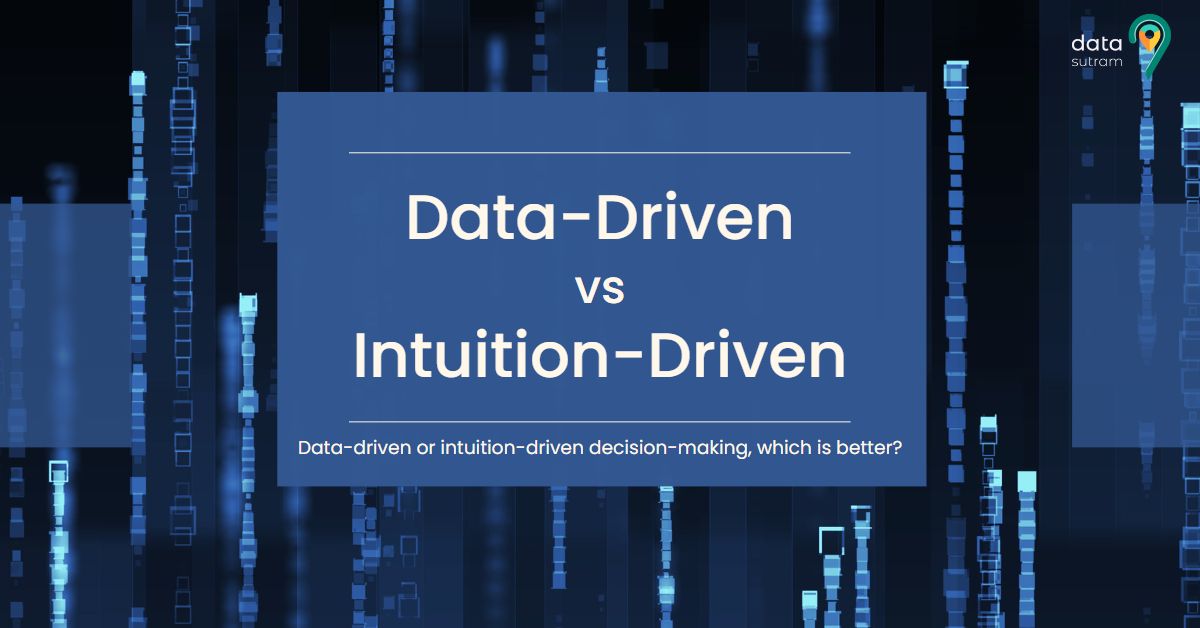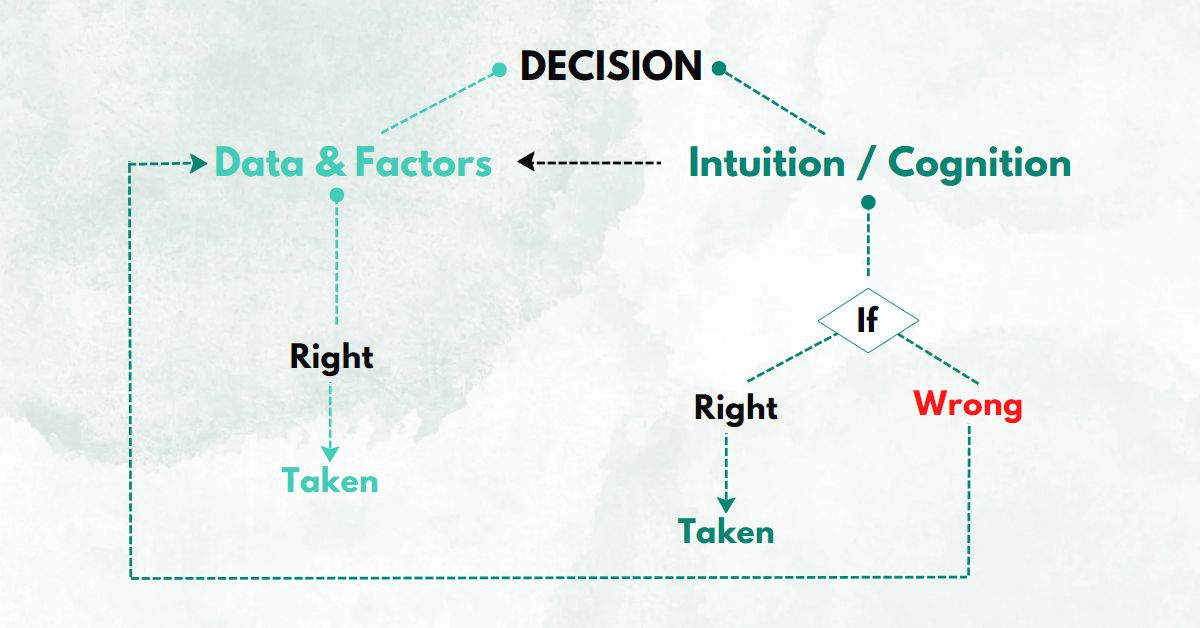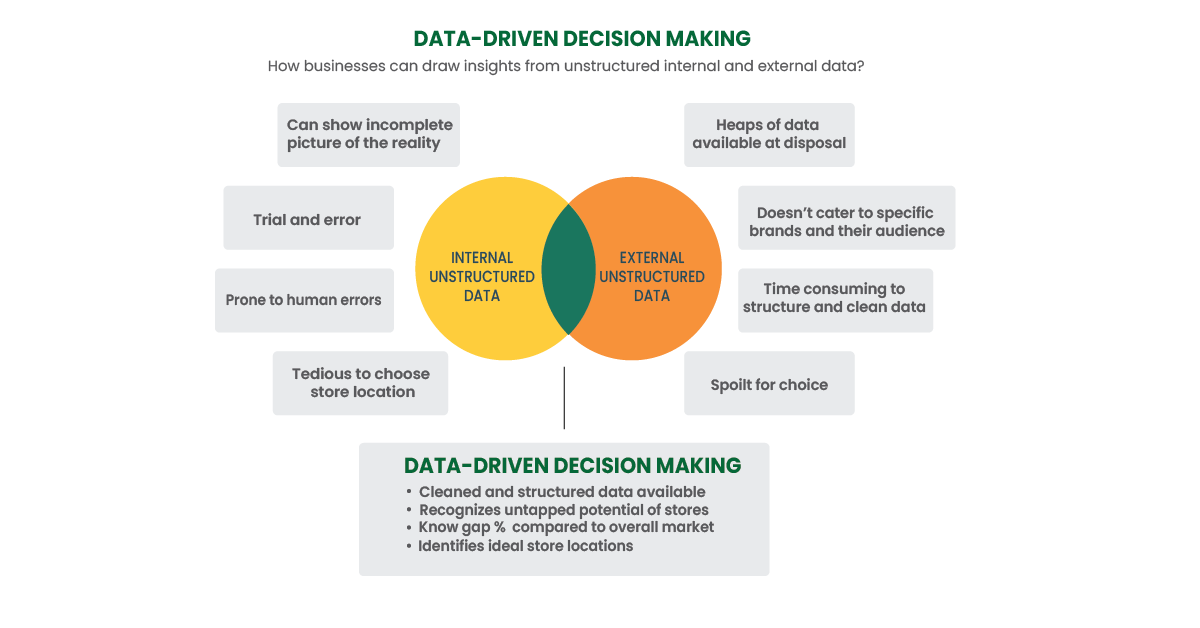Data-driven or intuition-driven decision-making, which is better?


Remember how you might have taken a longer route to work just because you left at a different time today and somehow knew you would reach early from a long way just because you sensed there might be less traffic then? Or estimate your calorie intake during your diet days; some days, you tend to lose weight, and others, you somehow gain.
Many decisions around us, by us, or sometimes even for us, are often a series of human brain analyses about the situation, looking at all the weighing factors. Finally, with a hint of gut feeling or obeying your cognition, the decision is taken. You might often consider all the data before proceeding, but the hint of gut feeling or formal cognition brings ambiguity. Let’s look at another example.
Remember Rahul from Retail Sutra? Much of his work was associated with sales, and his manager asked him to jot down potential business locations for the company to open new stores and grow. Before Rahul, this process was up and running, and people working on it had their approaches to deciding where to send the sales force. Like his former colleague Jaspreet, he targeted low suburb areas due to their high population density and created a plan of offers and discounts to attract a good crowd. Sounds like a good plan, but things didn’t turn out as planned. But why? A high population means more groups and better sales.
When making a decision, the backend of it broadly functions in two ways:
- Using data and factors
- Cognitive choices, i.e., intuition.

Unfortunately, Jaspreet didn’t consider the income group of the families living in the area and the overall affluence of the region. Traditionally, businesses have been opting for this approach; for many of them, this hit-or-miss approach has been a shot in the dark. For those of them, it worked; they always went ahead with it and were content with the results. A data-based approach might or might not have given the desired results, but the course felt more accurate. So which one is better, the data-driven approach or the intuition-driven approach?
What is data-driven decision-making?
Since Jaspreet went with his intuition, what would have been the other way? Enters data-driven decision-making. In simple terms, data-driven decision-making involves using data and statistical analysis to inform and guide decision-making, with the goal of basing decisions on verifiable facts and objective evidence.
But a lot of traditional sources need to provide an unclouded insight, and many businesses still have to opt for an intuition-driven approach. That’s where alternative data comes in. Alternative data refers to information that is not typically found in traditional data sources, such as financial statements or market research reports. It can come from sources like social media, satellite imagery, or internet search data. By incorporating this type of data into your decision-making process, you can gain valuable insights and perspectives that you may not have otherwise considered.
By combining traditional data sources with alternative data, you can build a more comprehensive picture of a situation and make more informed decisions. This approach can lead to improved outcomes and increased efficiency, as you are able to make decisions based on a broader range of information and evidence.
Data-driven decision-making vs. Intuition-driven decision-making?
Intuition-driven and data-driven approaches to decision-making are different in that intuition-driven decisions are based on personal experience, instincts, and gut feelings.
In contrast, data-driven decisions are based on verifiable facts, objective evidence and historical data.
Though intuition can be a helpful tool, especially in situations where time is limited or when the decision maker has a great deal of expertise in the subject, it can also lead to biases and mistakes. It is essentially a risky asset to drive business decisions because it might create a clouded scenario where no one can see what’s coming across. However, relying solely on intuition may not be the most reliable or accurate method for making decisions.
On the other hand, data-driven decision-making helps ensure that decisions are grounded in quantified historical occurrences rather than assumptions or subjective opinions. This can lead to more accurate and reliable decision-making and can help reduce the influence of biases and errors. But is only one sort of data enough?
RetailSutra being a fast-fashion company, wanted to expand aggressively and like we talked about, Jaspreet; similarly, a lot of employees were using the traditional source of data, i.e., the internal historical data. But as we’ve already seen that 90 out of 100 newly opened RetailSutra stores faced infrastructural and inventory losses. Why was it so despite the healthy demography in the area? Internal unorganized data might give us an insight into how the company might have performed well under historical conditions. Still, the non-dynamic nature of the internal information often does not map the present scenarios of the market, hence the unavailability of a complete purview.
It’s important to note that one approach is not inherently “better” than the other – both have their advantages and disadvantages. Even when data-driven, the best approach depends on combining internal historical data and external data insight. In many cases, it may be most effective to use a combination of both intuition and data to inform decision-making.
What is the significance of data-driven decision-making?
The ability in data-driven decisions provides a foundation upon which multiple businesses’ strategies and processes are laid. By utilizing data and extended data avenues like alternative and figurative analysis, decision-makers can gain a more precise and extensive understanding of a situation, leading to improved accuracy and reliability in decision-making.
Let’s look at the scenario where Rahul might not have taken Data Sutram’s external insight’s help and had to overturn the fortune of 90 loss-making stores. After extensive research and using the company’s internal data, Rahul would have proposed new stores, but would the ongoing trend derive the desired results for him and the company?
Instead, he leveraged the company’s historical data and external insight to look into the
- Gap Percentage
- Market Saturation.

While this not only helped him look at the entire market, he was also able to leverage alternative data to optimize the present loss-making stores, where he could select 50 potentially profitable locations.
Similarly, as Data Sutram helped Rahul and RetailSutra, different data points come up and can provide a well-rounded perspective and lead to more effective decision-making. Here data-driven decision-making creates the foundation for businesses to thrive.
What is the verdict?
A data-driven approach is essential because it provides a more objective and evidence-based method for making decisions, reducing the risk of biases and errors and leading to improved accuracy and reliability. As we propagate toward a future of web-based technology and the introduction of Web3, every sector is getting dependent on data, and why wouldn’t they?
Intuition provides us with unorganized, non-quantified pieces of information assembled from personal experiences, expected trends and influenced details. Though this information isn’t completely irrelevant, historical data from experiences need to be quantified and put against pertinent parameters so that the intuition can be churned into data and become something relevant in utility.
We saw that Rahul tried to map his existing store attributes like sales, store size, nearby SKUs, and competitors. Data Sutram helped them merge it with the alternative data parameters such as footfall, affluence, and income group of the geographical area, which allowed them to understand the viability of the insights Data Sutram provided. Where he realized that out of all the 100 stores, only 50 were going to profit RetailSutra, and the others needed to be more vital locations.
New data avenues like alternative data are aiding companies with more accurate business decisions, giving them a complete purview of business solutions; companies like Data Sutram and technologies like Sales Intelligence help them better understand varied demographies and deeper geographies. Data is referred to as the new oil, then the new soil, and also a currency sometimes; all in all, adopting it as an asset has been a necessity for almost every business, and as much as we interact with it keeps growing and becoming more accurate.